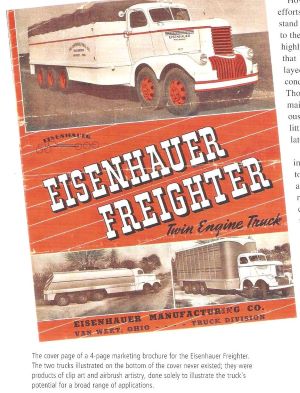 What do you get when you combine two Chevrolet trucks, twin engines, eight-wheel drive, and a whole lot of ambition? In postwar Van Wert, Ohio, Leigh Eisenhauer Sr. had the answer: the Eisenhauer Freighter, a revolutionary prototype truck designed to haul 40,000 pounds with agility, efficiency, and flair. Built for a world hungry for innovation, this bold creation wasn’t just a truck—it was a statement.
What do you get when you combine two Chevrolet trucks, twin engines, eight-wheel drive, and a whole lot of ambition? In postwar Van Wert, Ohio, Leigh Eisenhauer Sr. had the answer: the Eisenhauer Freighter, a revolutionary prototype truck designed to haul 40,000 pounds with agility, efficiency, and flair. Built for a world hungry for innovation, this bold creation wasn’t just a truck—it was a statement.
The Freighter started with a pair of medium-duty Chevrolet 1.5-ton trucks, brought together to form a 35-foot-long colossus—25 feet of which was uninterrupted cargo bed. Powering this beast were two 235 cubic-inch Chevrolet inline-six engines, mounted in an unconventional configuration: one under the hood and the other beneath the driver’s seat in a cab-over setup.
Together, they delivered 83.5 horsepower and 182 pound-feet of torque per engine, controlled by shared gas and clutch pedals. But here’s where things got interesting: the transmissions were operated independently. Drivers had to shift each engine’s gears separately, with air cylinders and "differential type synchronizers" lending a helping hand—possibly through pneumatic automation.
Power from the engines flowed to twin Timken two-speed rear axles. The front engine drove the leading axle, the rear engine powered the trailing axle, and the middle axle was unpowered. All three were duallys, individually sprung, and the rearmost axle sat on a pivoting subframe that allowed rear-wheel steering. Combined with two steered front axles, this unique system gave the truck remarkable maneuverability—on paper, at least. Reverse gear even locked the rear steering axle in place, ensuring stability in tight spots.
But the Freighter wasn’t just built to perform—it was built to impress. When the truck debuted in Detroit at General Motors’ Golden Anniversary parade in 1946, it stole the show. The truck’s innovative design was showcased in 65 trade magazines, and suppliers of its components leveraged its fame in their advertising campaigns.
Despite the buzz, the Freighter’s story stalled. Potential buyers were told that production was “delayed due to certain conditions in the industry.” A second attempt in 1957, featuring five X-2 prototypes with GMC engines and Hydra-Matic transmissions, made it as far as U.S. Army trials but failed to take off.
Though it never reached mass production, the Eisenhauer Freighter lives on as a symbol of innovation, ambition, and postwar ingenuity. With its twin engines, complex drivetrains, and groundbreaking steering system, it represents the kind of bold thinking that dares to rewrite the rules—even if only for a moment.
_____
Celebrate Trucking History with ATHS!
For just $24 a year, you’ll get full access to the Wheels of Time digital magazine six times a year, online resources, and the chance to connect with a passionate community of trucking enthusiasts. Prefer print? Upgrade anytime! Sign up now and help keep trucking history alive: aths.org/membership/become-a-member.